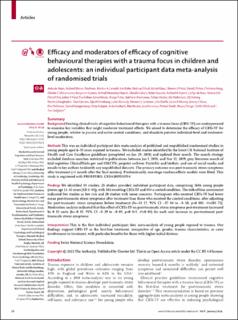| dc.contributor.author | de Haan, Anke | |
| dc.contributor.author | Meiser-Stedman, Richard | |
| dc.contributor.author | Landolt, Markus A. | |
| dc.contributor.author | Kuhn, Isla | |
| dc.contributor.author | Black, Melissa J | |
| dc.contributor.author | Klaus, Kristel | |
| dc.contributor.author | Patel, Shivam D | |
| dc.contributor.author | Fisher, David J | |
| dc.contributor.author | Haag, Christina | |
| dc.contributor.author | Ukoumunne, Obioha C | |
| dc.contributor.author | Jones, Benjamin G | |
| dc.contributor.author | Flaiyah, Ashraf Muwafaq | |
| dc.contributor.author | Catani, Claudia | |
| dc.contributor.author | Dawson, Katie | |
| dc.contributor.author | Bryant, Richard A | |
| dc.contributor.author | de Roos, Carlijn | |
| dc.contributor.author | Ertl, Verena | |
| dc.contributor.author | Foa, Edna B | |
| dc.contributor.author | Ford, Julian D. | |
| dc.contributor.author | Gilboa-Schechtman, Eva | |
| dc.contributor.author | Tutus, Dunja | |
| dc.contributor.author | Hermenau, Katharin | |
| dc.contributor.author | Hecker, Tobias | |
| dc.contributor.author | Hultmann, Ole | |
| dc.contributor.author | Axberg, Ulf | |
| dc.contributor.author | Jaberghaderi, Nasrin | |
| dc.contributor.author | Jensen, Tine K. | |
| dc.contributor.author | Ormhaug, Silje M. | |
| dc.contributor.author | Kenardy, Justin | |
| dc.contributor.author | Lindauer, Ramon J L | |
| dc.contributor.author | Diehle, Julia | |
| dc.contributor.author | Murray, Laura K. | |
| dc.contributor.author | Kane, Jeremy C. | |
| dc.contributor.author | Peltonen, Kirsi | |
| dc.contributor.author | Kangaslampi, Samuli | |
| dc.contributor.author | Robjant, Katy | |
| dc.contributor.author | Koebach, Anke | |
| dc.contributor.author | Rosner, Rita | |
| dc.contributor.author | Rossouw, Jaco | |
| dc.contributor.author | Smith, Patrick | |
| dc.contributor.author | Tonge, Bruce J. | |
| dc.contributor.author | Hitchcock, Caitlin | |
| dc.contributor.author | Dalgleish, Tim | |
| dc.date.accessioned | 2024-02-06T10:04:18Z | |
| dc.date.available | 2024-02-06T10:04:18Z | |
| dc.date.created | 2023-11-21T17:09:09Z | |
| dc.date.issued | 2023 | |
| dc.identifier.citation | The Lancet Child and Adolescent Health. 2023, | en_US |
| dc.identifier.issn | 2352-4642 | |
| dc.identifier.uri | https://hdl.handle.net/11250/3115852 | |
| dc.description | This is an Open Access article under the CC BY 4.0 license. Print version: 2024. 8, (1), 28-39 | en_US |
| dc.description.abstract | Background: Existing clinical trials of cognitive behavioural therapies with a trauma focus (CBTs-TF) are underpowered to examine key variables that might moderate treatment effects. We aimed to determine the efficacy of CBTs-TF for young people, relative to passive and active control conditions, and elucidate putative individual-level and treatment-level moderators.
Methods: This was an individual participant data meta-analysis of published and unpublished randomised studies in young people aged 6−18 years exposed to trauma. We included studies identified by the latest UK National Institute of Health and Care Excellence guidelines (completed on Jan 29, 2018) and updated their search. The search strategy included database searches restricted to publications between Jan 1, 2018, and Nov 12, 2019; grey literature search of trial registries ClinicalTrials.gov and ISRCTN; preprint archives PsyArXiv and bioRxiv; and use of social media and emails to key authors to identify any unpublished datasets. The primary outcome was post-traumatic stress symptoms after treatment (<1 month after the final session). Predominantly, one-stage random-effects models were fitted. This study is registered with PROSPERO, CRD42019151954.
Findings: We identified 38 studies; 25 studies provided individual participant data, comprising 1686 young people (mean age 13·65 years [SD 3·01]), with 802 receiving CBTs-TF and 884 a control condition. The risk-of-bias assessment indicated five studies as low risk and 20 studies with some concerns. Participants who received CBTs-TF had lower mean post-traumatic stress symptoms after treatment than those who received the control conditions, after adjusting for post-traumatic stress symptoms before treatment (b=−13·17, 95% CI −17·84 to −8·50, p<0·001, τ2=103·72). Moderation analysis indicated that this effect of CBTs-TF on post-traumatic stress symptoms post-treatment increased by 0·15 units (b=−0·15, 95% CI −0·29 to −0·01, p=0·041, τ2=0·03) for each unit increase in pre-treatment post-traumatic stress symptoms.
Interpretation: This is the first individual participant data meta-analysis of young people exposed to trauma. Our findings support CBTs-TF as the first-line treatment, irrespective of age, gender, trauma characteristics, or carer involvement in treatment, with particular benefits for those with higher initial distress.
Funding: Swiss National Science Foundation. | en_US |
| dc.language.iso | eng | en_US |
| dc.publisher | Elsevier | en_US |
| dc.rights | Navngivelse 4.0 Internasjonal | * |
| dc.rights.uri | http://creativecommons.org/licenses/by/4.0/deed.no | * |
| dc.subject | adolescents | en_US |
| dc.subject | children | en_US |
| dc.subject | trauma focus | en_US |
| dc.subject | cognitive behavioural therapies | en_US |
| dc.title | Efficacy and moderators of efficacy of cognitive behavioural therapies with a trauma focus in children and adolescents: an individual participant data meta-analysis of randomised trials | en_US |
| dc.type | Peer reviewed | en_US |
| dc.type | Journal article | en_US |
| dc.description.version | publishedVersion | en_US |
| dc.rights.holder | © 2023 The Author(s). Published by Elsevier Ltd. | en_US |
| dc.source.pagenumber | 28-39 | en_US |
| dc.source.journal | The Lancet Child and Adolescent Health | en_US |
| dc.identifier.doi | 10.1016/S2352-4642(23)00253-5 | |
| dc.identifier.cristin | 2199899 | |
| cristin.ispublished | true | |
| cristin.fulltext | original | |
| cristin.qualitycode | 2 | |

